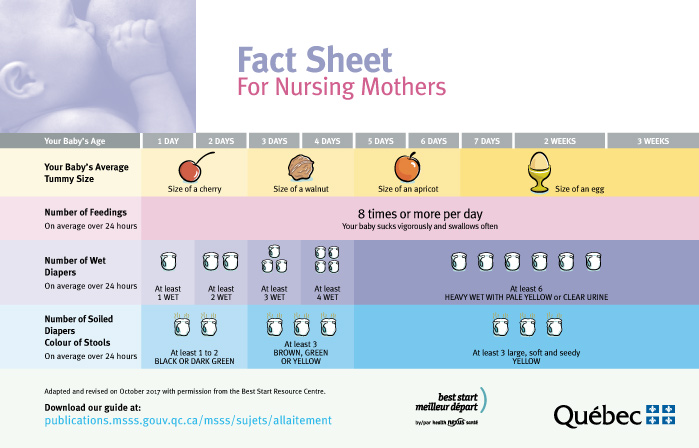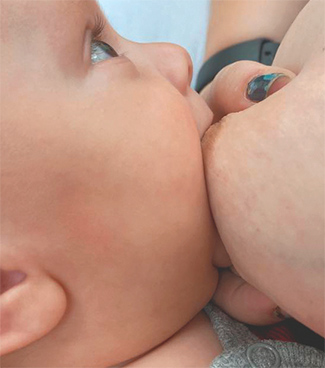How often to nurse—and how long?
![]() When you’re breastfeeding, don’t watch the clock—watch your little one. Trying to nurse on a schedule won’t protect against irritated nipples and could deprive your baby of needed nourishment. Better to watch your baby for signs of hunger and satisfaction!
When you’re breastfeeding, don’t watch the clock—watch your little one. Trying to nurse on a schedule won’t protect against irritated nipples and could deprive your baby of needed nourishment. Better to watch your baby for signs of hunger and satisfaction!
How often you nurse varies a great deal from one baby to another. What’s important is that your baby latches on properly, nurses effectively and swallows your milk.
Mother’s milk is rapidly digested, and infants’ stomachs are small, so it’s normal to breastfeed frequently during the first weeks of life. When you’re at the learning stage, the process of nursing, stimulating, burping and diaper‑changing can take from 45 to 90 minutes. With time, as your baby develops the ability to nurse more effectively, breastfeedings will become shorter and less frequent.
During growth spurts, your baby will nurse more frequently during the day and at night—sometimes as often as every hour. Frequent breastfeeding increases milk production. This is a passing phase, but it’s a very intense one for moms. Family support can be very important during these periods.
Giving your baby commercial infant formula or baby cereal results in less stimulation for your breasts and may interfere with milk production.
Does your baby seem satisfied after nursing, only to seek your breast 15 or 20 minutes later? That’s completely normal, especially during the first weeks. Don’t hesitate to nurse again for a little “dessert”.

Cluster feeding
Feedings are more frequent at certain hours of the day and less frequent at other times. Evenings can be a challenging time because most babies tend to get cranky and nurse a lot. They sleep a bit, cry a bit, nurse a bit and need comforting. Some babies may want to nurse almost non-stop for a few hours. They may then sleep for longer periods. “Cluster feeding” is normal, although it can leave you with the impression you don’t have enough milk because your breasts are soft and have less time to produce new milk.
One breast or two? Or more?
The number of times that your baby will want to change breasts during a feeding will depend on
- The quantity of milk accumulated in the breast
- His appetite and age
- The time of day
Your baby might nurse from one breast or both during a feeding, and you should go along with his preference. Let him nurse from the first breast until he’s full. When he starts to let go or becomes drowsy, try burping him. Then offer the other breast: he’ll take it if he’s still hungry.
You can change breasts more than once during a feeding. Some babies release the breast as the flow of milk slows. Offering the second breast gives the milk glands in the first breast a chance to refill. If your baby isn’t full after nursing at the second breast, he can return to the first one. And if he’s still hungry, change once more to give him the second breast again.
At the next feeding, start with the breast that was offered last or the one your baby nursed from least. If you don’t remember, offer the breast that feels heavier.
Breast compression

Photo: Manon Methot
Breast compression is a technique you can use if your baby has trouble getting the milk he needs. It increases milk flow. Use this technique if your baby
- Falls asleep quickly when nursing
- Isn’t gaining enough weight
- Wants to nurse very often or for long periods
- Seems dissatisfied after feeding
It’s also a very good way to get your baby drinking colostrum during the first few days of life.
Position your thumb on one side of your breast and your fingers on the other in a squeeze position. Place your fingers close to the areola, but far enough away that you don’t interfere with your baby’s suction. Squeeze the breast with your whole hand without moving your fingers. This should not be painful or stretch the areola.
Maintain pressure for 5 to 10 seconds or as long as your baby continues swallowing. Release the pressure as soon as he stops drinking, then start again, continuing until he stops swallowing. Offer the other breast in the same way if your baby seems to want it. You can return to the first breast—and the second one again—if needed. You can stop using this technique once your baby starts drinking enough.
Comfort nursing
Breastfeeding is more than a way to provide your baby with nourishment. Letting your baby nurse for comfort won’t create bad habits. In many cultures, breastfeeding is used as much to calm infants as it is to nourish them.
In addition to nursing your baby to comfort him, you can provide skin-to-skin contact, rock him, or carry him in your arms to soothe him.
Some parents also give their children a pacifier (soother) to comfort them.

The Canadian Paediatric Society makes the following recommendations about pacifiers:
- ”It’s best not to start using a pacifier until breastfeeding is going well. Talk to your doctor or lactation specialist if you feel your baby needs to use one at this early stage. One exception is for premature or sick babies in the hospital who can benefit from using one for comfort.“
- ”Always see if your baby is hungry, tired or bored before giving him the pacifier. Try solving these things first“.
Areola: Darker area of the breast around the nipple.


